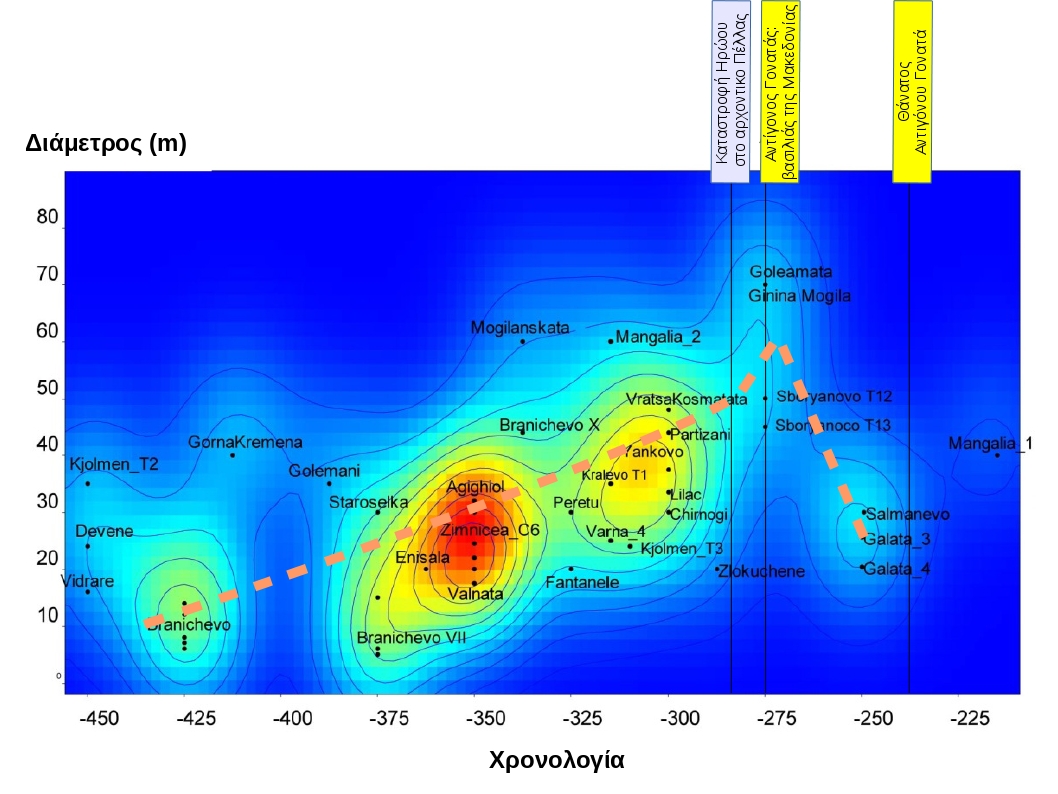The uncalibrated radiocarbon age is 2250 BP plus/minus 30 years. Whoever wants to make exact calculations instead of drawing lines by eye on the plot Andrew supplied, can use the latest calibration curve for the northern hemisphere for which the data is here:
http://www.radiocarbon.org/IntCal13.htm (File intcal13.14c - just save it as a .csv file and it will open in your Excel, if you know how to use that).
Essentially, this should be the curve the team has used, it includes the variation in atmospheric carbon that causes all the dating problems.
Below I try to list some of the data/facts I could extract from the interviews. If I add interpretations that the team has provided, it is only where they appear to me sensible, which does not necessarily mean they are, so be critical.
-The supposed head of Hephaestion from Louvre is from Thassian marble, found in Amphipolis in the 19th century, exact location is unknown, and was part of a bas relief, not a free standing statue.
-The frieze in the chambers was painted with the encaustic method and there is no background (φοντο?) (argument used for dating the monument)
-The caryatids where formed on site by the sculptors, they are part of the wall, no connectors/ clumps appear to hold them on the wall structure of the chambers. They are just continuous with the wall structure. They cannot be later additions
-The sphinx head fits with the body. They made replicas of the neck, that includes the connector holes, and managed to fit it perfectly with the sphinx body. Inclination of the connector holes suggest that the surviving sphinx head was looking outwards, the other inwards.
-The right front foot of each sphinx is slightly more forward than the left
-They know from the reconstructed wings and the connecting holes that survive, that they were large and pointing down, so they fit the available space in the entrance of Kastas. If the Sphinxes were transferred from elsewhere, it would have been a huge coincidence that the wings did not intersect the chamber's structure (that comment was due to the suggestion by some attendants that the sphinxes where resused from a different monument)
-They plan to add the reconstructed wings on the sphinxes at some later point
-3 additional pieces attributed to the lion found, 2 near the Strymon, one at Kastas.
-Lefantzis said he only read ΑΡΕΛΑΒΟΝ plus an Η & Ν in a monogram, so I assume the rest of the deciphering we have seen comes from an epigraphologist. They already clarified that inscriptions have been given to experts.
-The team will use more samples for carbon dating or the chamber's construction
-They have also performed carbon dating of tumulus samples and preliminary results indicate at least two phases of the artificial tumulus formation (no dates that I can find).
-The threshold of the door, behind the door location in the burial chamber has an ionian molding that matches the ionian molding of the door's lintel - which is how it was identified that it was placed in its final location for a second use and that the door was a later addition. Originally there was no door, so the last chamber was accessible, as it is assumed it fits for a heroon.
-The cist tomb was separated in two parts, one for a kline, and one for an urn. The small space is assumed to have been for an urn because at its base they located ashes, while in the burial chamber they also discovered a metallic urn handle.
-There is a large broken part of the east marble door, assumed to have happened due to a raid, not due to natural disasters. The doors where locked/blocked after some period of time, I assume they were too heavy or difficult to be opened in a normal way by the looters.
-A 1-2 day workshop for Kastas is planned in the near future where many more details will be presented to experts that will attend.
Lots of more stuff are written, mostly interpretations and criticism, that maybe subject for another post.
If you want to try google translate, here are the links:
http://www.protothema.gr/greece/article ... kataferan/
http://www.tovima.gr/society/article/?a ... E%BB%CE%B7
http://www.tovima.gr/society/article/?a ... E%BB%CE%B7